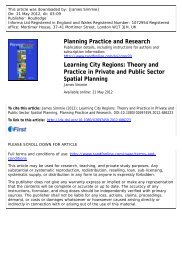History Matters: Path dependence and innovation in British city ...
History Matters: Path dependence and innovation in British city ...
History Matters: Path dependence and innovation in British city ...
You also want an ePaper? Increase the reach of your titles
YUMPU automatically turns print PDFs into web optimized ePapers that Google loves.
Table 20: Employment <strong>in</strong> creative <strong>in</strong>dustries<br />
Indicator<br />
Time series<br />
Data source<br />
Geographic basis<br />
Def<strong>in</strong>itions<br />
Percentage of <strong>city</strong>-region’s employees <strong>in</strong> creative <strong>in</strong>dustry sectors.<br />
1981, 1991, 2005 (economic trough years).<br />
ONS: 1981 Census of Employment; 1991 Annual Employment Survey; 2005 Annual Bus<strong>in</strong>ess<br />
Inquiry.<br />
Data for local authority districts is best-fit to 1998 TTWA boundaries (pre-1996 districts are<br />
used for 1981 data).<br />
The def<strong>in</strong>ition of creative <strong>in</strong>dustry sectors is based on that used by the Department for<br />
Culture, Media & Sport, although some variations are necessary <strong>in</strong> order to obta<strong>in</strong> comparable<br />
time series data back to 1981.<br />
For 1991 <strong>and</strong> 2005, the def<strong>in</strong>ition is based on the 1992 SIC <strong>and</strong> <strong>in</strong>cludes the follow<strong>in</strong>g<br />
activity codes: 22 (publish<strong>in</strong>g & pr<strong>in</strong>t<strong>in</strong>g), 72 (computer & related activities), 74.2<br />
(architecture, eng<strong>in</strong>eer<strong>in</strong>g & related technical consultancy), 74.3 (technical test<strong>in</strong>g &<br />
analysis), 74.4 (advertis<strong>in</strong>g), 74.81 (photographic activities), 92.1 (motion picture & video<br />
activities), 92.2 (radio & TV activities), 92.31 (artistic & literary creation), 92.32 (operation of<br />
arts facilities), 92.4 (news agency activities).<br />
For 1981, the def<strong>in</strong>ition is based on the 1980 SIC, <strong>and</strong> <strong>in</strong>cludes the follow<strong>in</strong>g activity<br />
codes: 34.52 (gramophone records/pre-recorded tapes), 47.5 (pr<strong>in</strong>t<strong>in</strong>g/publish<strong>in</strong>g), 49.3<br />
(photographic process<strong>in</strong>g), 83.7 (professional/technical services), 83.8 (advertis<strong>in</strong>g), 83.94<br />
(computer services), 97.11 (film production, distribution/exhibition), 97.41 (radio/TV<br />
services, theatres, etc.), 97.6 (authors, composers/own account artists).<br />
Comments<br />
There is a degree of overlap between the creative <strong>in</strong>dustries <strong>and</strong> KIBS sector def<strong>in</strong>itions (see<br />
below); 1992 SIC codes 72, 74.2, 74.3 <strong>and</strong> 74.4 are <strong>in</strong>cluded <strong>in</strong> both def<strong>in</strong>itions.<br />
Table 21: Innovation outcomes<br />
Indicator<br />
Time series<br />
Data source<br />
Geographic basis<br />
Def<strong>in</strong>itions<br />
Comments<br />
Percentage of firms <strong>in</strong>troduc<strong>in</strong>g new or novel products; new or novel processes; <strong>and</strong> wider<br />
forms of <strong><strong>in</strong>novation</strong> (i.e. new corporate strategy; advanced management techniques; changes<br />
to organisational structure; <strong>and</strong> changes to market<strong>in</strong>g strategy).<br />
CIS4 survey covers <strong><strong>in</strong>novation</strong> activities <strong>in</strong> 2002-2004.<br />
DTI, UK Innovation Survey 2002-04 (CIS4) dataset.<br />
The CIS4 dataset uses the firm’s postcode sector as a geographic reference; this is used to<br />
allocate firms to 1998 TTWAs.<br />
‘New’ products/processes are def<strong>in</strong>ed as products/processes new to the firm, but not<br />
necessarily new to the market or <strong>in</strong>dustry (significantly improved products/processes are also<br />
<strong>in</strong>cluded <strong>in</strong> the def<strong>in</strong>ition). ‘Novel’ products/processes are def<strong>in</strong>ed as products/processes<br />
new to the firm’s market or <strong>in</strong>dustry, i.e. <strong>in</strong>troduced by the firm before its competitors.<br />
None.<br />
87













